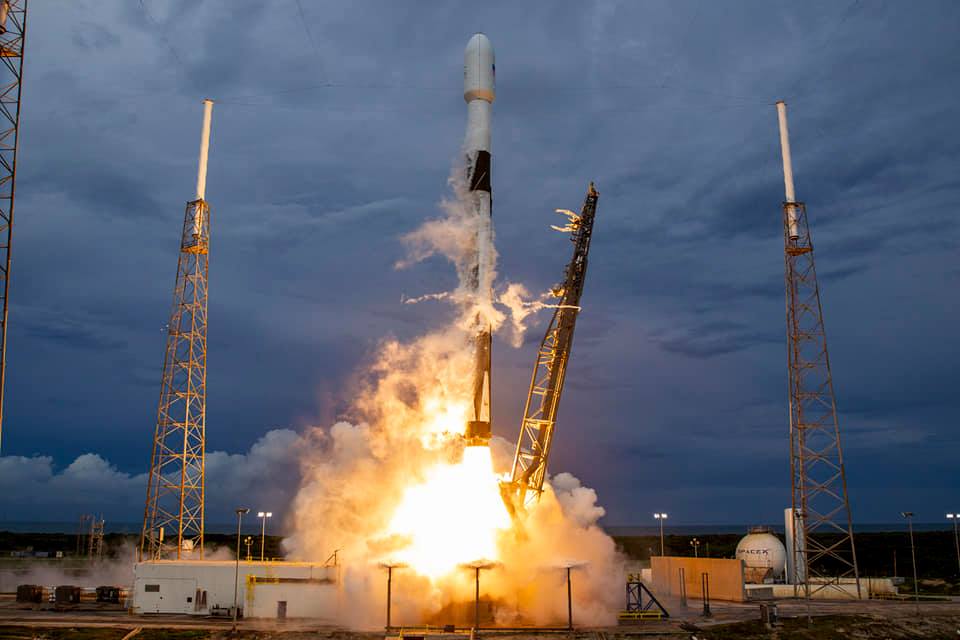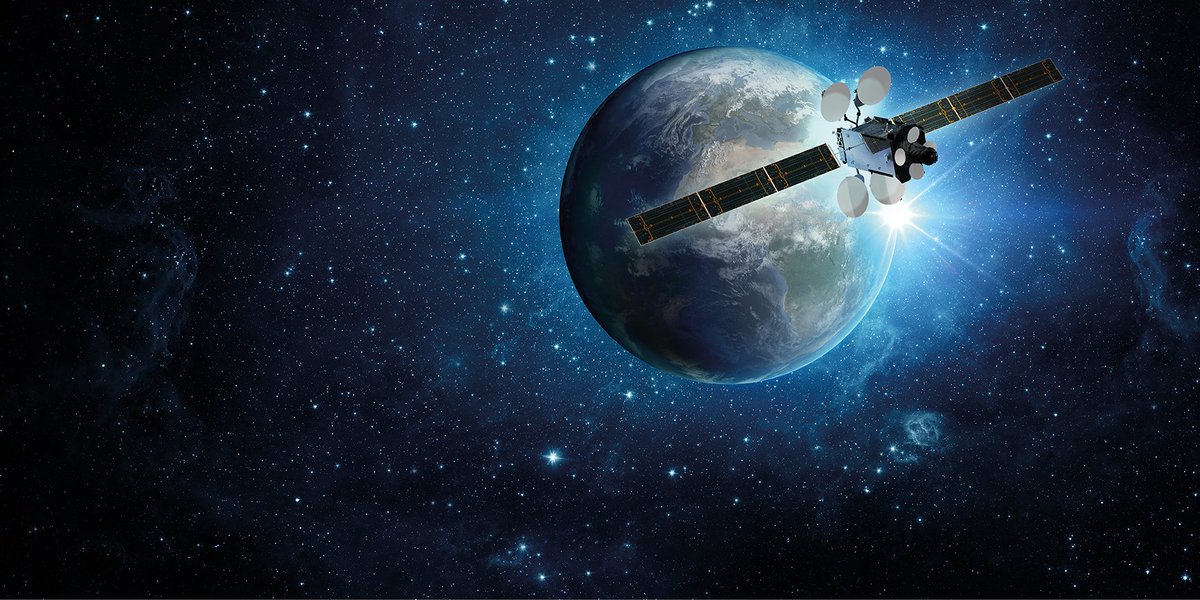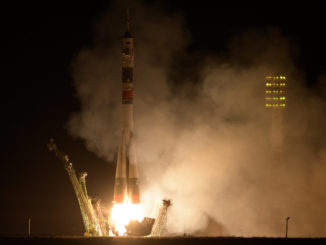
SpaceX carried the Israeli-owned Amos 17 communications satellite from Cape Canaveral into orbit Tuesday on top of a Falcon 9 launcher, nearly three years after a SpaceX rocket explosion destroyed a predecessor payload before it could get off the ground.
A 229-foot-tall (70-meter) Falcon 9 rocket lifted off from Cape Canaveral with Spacecom Ltd.’s Amos 17 spacecraft on-board at 7:23 p.m. EDT (2323 GMT) after a half-hour delay to wait for stormy weather to clear the area.
Nine Merlin 1D engines roared to life with 1.7 million pounds of combined thrust to push the launcher into a gloomy evening sky, backdropped by dark clouds from nearby thunderstorms.
Tuesday’s mission profile came close to filling all of the Falcon 9’s lift capability, and SpaceX did not attempt to recover the Falcon 9 rocket’s first stage. The 14,330-pound (6.5-metric ton) Amos 17 spacecraft required a significant boost from the Falcon 9 to reach an elliptical transfer orbit stretching more than 22,000 miles (nearly 36,000 kilometers) above Earth, leaving insufficient leftover fuel in the first stage to attempt a controlled landing.
Nevertheless, SpaceX did notch a separate achievement Tuesday in the company’s effort to recover and reuse rocket hardware.
Elon Musk, SpaceX’s founder and CEO, reported on Twitter that the company’s offshore vessel “Ms. Tree” successfully caught one half of the Falcon 9 rocket’s payload fairing in the Atlantic Ocean after Tuesday night’s launch.
The shroud protected the Amos 17 spacecraft during the first few minutes of flight through the dense, lower layers of the atmosphere. Once in space, rocket jettisoned the clamshell-like shroud in two pieces because it was no longer needed.
In a launch industry first, SpaceX has fitted the fairing halves with control thrusters and parafoils to slow their descent from space back through the atmosphere. Ms. Tree has a giant net to capture the fairing as it gently comes back to Earth.
SpaceX’s Ms. Tree recovery ship caught a fairing for the first time after a Falcon Heavy launch in June. Tuesday night’s catch marked the second time Ms. Tree has netted a fairing, after numerous previous tries came up empty.
Rocket fairing falling from space (higher res) pic.twitter.com/sa1j10qAWi
— Elon Musk (@elonmusk) August 7, 2019
Elon Musk, SpaceX’s founder and CEO, told reporters last year that the fairing costs around $6 million.
The other half of the shroud from Tuesday night’s mission with Amos 17 splashed down in the ocean under a separate parachute. Teams on a SpaceX vessel planned to pull the structure from the sea and return it to port with the fairing half caught by Ms. Tree.
As SpaceX’s downrange recovery crew retrieved the Falcon 9 fairing, the rocket’s upper stage fired its main engine two times to hurl the Amos 17 satellite into an elliptical transfer orbit en route to its final operating station in geostationary orbit over the equator.
The Falcon 9’s upper stage released Amos 17 around 32 minutes after liftoff into an on-target orbit, officials said.
Ground controllers from Boeing, which built the Amos 17 spacecraft, acquired the first radio signals from the satellite later Tuesday night, confirming its health after launch.
Over the next few weeks, Amos 17 will use an on-board engine to circularize its orbit at geostationary altitude more than 22,000 miles over the equator. The satellite will unfurl its solar panels and reflector antennas, and ground controllers will put Amos 17 through a comprehensive post-launch checkout before handing it over to Spacecom to begin commercial service later this year.
In geostationary orbit, Amos 17’s velocity will match the rate of Earth’s rotation, and the satellite will park at 17 degrees east longitude, in range of customers across Africa, Europe, Asia and the Middle East. From the point-of-view of ground users, Amos 17 will remain at a fixed position in the sky.
Spacecom says the $250 million Amos 17 satellite is designed for a 20-year lifetime.
Amos 17 will replace the Amos 5 satellite at 17 degrees east, which failed in 2015. The new satellite carries C-band, Ku-band and Ka-band communications payloads to provide television broadcast, broadband Internet and other networking and data relay services.
David Pollack, Spacecom’s president and CEO, said Amos 17 has a “smart payload” that can be reprogrammed from the ground to meet changing market demands.
“This satellite is based on our 702 heritage bus,” said Chris Johnson, president of Boeing Satellite Systems, which built Amos 17 in El Segundo, California. “It has a highly flexible payload and digital channelizer that is at the cutting edge, and will give Spacecom the ability to adjust and provide flexibility for changing user coverage for different mission needs, and to be able to do a lot of reconfiguration on orbit to meet the growing demand.”
Similar reprogrammable digital payloads have flown on previous Boeing satellites, including on the U.S. Air Force’s newest Wideband Global SATCOM communications spacecraft, and on Intelsat’s “Epic” video, data and Internet relay satellites.
But Amos 17 is the first satellite to carry a channelizer to route data using three different communications bands. The digital payload can automatically switch between bands for data uplinks and downlinks, without requiring any special equipment from users.

Tuesday’s launch marked the return of Spacecom to Cape Canaveral for the first time since the company’s Amos 6 communications satellite was destroyed during a catastrophic explosion minutes before a planned test-firing of a Falcon 9 rocket on the launch pad in September 2016.
SpaceX’s investigation concluded that a composite overwrapped pressure vessels, or COPV, inside the second stage’s liquid oxygen tank suddenly ruptured during fueling of the Falcon 9 rocket, triggering the 2016 explosion.
The company changed procedures after the accident, and began flying with a new vessel design last year.
“This was a bad accident for us,” Pollack said in a pre-launch briefing with reporters last week. “The insurance supported us, and they paid everything to the satisfaction of our borrowers. So from that regard, we were OK. The markets supported us.”
Amos 17 is not a direct replacement for the Amos 6 satellite lost in the 2016 accident. The new satellite is designed to operate in a different geostationary slot, and Amos 17 carries a more sophisticated communications payload.
But Spacecom’s agreement with Facebook to use the Amos 6 satellite to expand broadband connectivity in Africa is not continuing with Amos 17, Pollack said.
“We had a design to service Africa with Amos 6,” he said. “We had a pre-launch contract with Facebook, and we were going together to serve Africa … We had plans for that satellite. It all was exploded, and I’m very sorry for that, and it delayed our programs.
“It was a significant setback for us. But like in the old James Bond movies, we did like this (brushing dust off his shoulders), and we are here with Amos 17 and ready to go.”
Spacecom’s decision to use a Falcon 9 rocket again came after an assessment of SpaceX’s launch statistics and financial considerations, Pollack said.
In a 2017 statement released after selecting SpaceX for the Amos 17 launch, Spacecom said it would “use full credits from Amos 6’s unfulfilled September 2016 launch to fully cover Amos 17’s launch fees.”
”They owe us a launch,” Pollack said last week.
“If you go back from then until now, they have a very perfect history of launches,” Pollack said. “I believe they are doing a very good job.”
SpaceX has rarely intentionally disposed of a Falcon booster since the newest generation of the Falcon 9 rocket, named the Block 5, debuted last year.
At nearly 7.2 tons fully fueled, Amos 17 is a hefty spacecraft. The satellite needed all of the Falcon 9’s performance to reach its targeted geostationary transfer orbit.
But Falcon 9 rockets have deployed heavier geostationary communications satellites in lower orbits before. In those cases, the satellites had to consume more of their own propellant to reach their operating posts.
With the higher orbit achieved Tuesday, Amos 17 is closer to its final orbital position, and the satellite will have enough fuel to function for 20 years, according to Spacecom.
The tradeoff is that SpaceX could not recover the Falcon 9’s first stage, a veteran of two previous launches and landings in 2018.
Pollack declined to discuss any specifics of Spacecom’s agreement with SpaceX, such as provisions for the Amos 17 transfer orbit. But he touted the satellite’s expected long life.
“This satellite cost us about $250 million in orbit. We hope to recover it, within what is acceptable within the industry, in about six or seven years,” Pollack said. “And then, because it’s 20 years, we have hopefully a long life to make profit.”
Email the author.
Follow Stephen Clark on Twitter: @StephenClark1.



